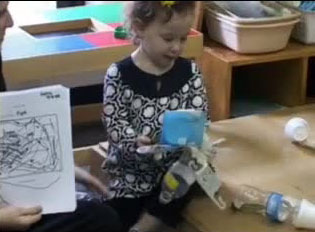About this video
This clip shows part of a “study group” meeting of four preschoolers and their teacher at University Primary School in Champaign, Illinois. Along with another mixed-age classroom, this class has been investigating ways to turn the school playground into an outdoor learning area. The four children shown here, plus another child who is absent, are in the “Ramps and Slides” study group.
The children in the study group used a commercially made marble run to learn about how materials move on ramps and slides. They focused on ways to slow a marble’s progression from the top to the bottom of the marble run. Then they applied what they learned from that experience when they drew plans for the slides to go with a water feature that is being planned for the outdoor learning area. (They referred to these plans as “designs.”) Then they used items they chose from the school’s supply of recycled materials to make models based on their designs.
In this video clip, the study group meets with their teacher, Becca, and a visitor to talk about their finished models. The children expect to take turns describing their models and how they think the models will work while Becca holds their drawings.
This clip begins immediately after Becca has held Sylvie’s (3 years, 10 months) drawing up for the group to see and asked Sylvie to explain how her model will work.
Sylvie holds her model and points to the various parts of it as she explains how she thinks the water will flow through it. She uses a combination of words and gestures to express her ideas.
Becca then summarizes Sylvie’s comments, restating one of Sylvie’s goals in designing her model: to create a slide that would slow the water down, so that it will take “a longer time to get to the bottom.”
When they have finished talking about Sylvie’s model, Becca asks the children if they think the finished slide will look exactly like their models. Before she can finish her sentence, Simon (4 years, 5 months) begins to comment. He has noticed a way to connect his model and Sylvie’s. He uses a combination of words and gestures to describe what he is thinking.
Becca asks a clarifying question, summarizes what Simon says for the group, and checks with him to make sure she has understood his idea.
Video
Transcript
Sylvie: (Pointing to different parts of her model.) Well, this one is where it starts and then it goes all the way, but it takes a long time when it drops. So it starts here and it goes all the way, out of—and it starts here and goes here, and then it goes there, and then it goes there, and then it goes there, and then it goes there, and then it goes here, and then it goes there, and then it goes THERE!
Becca: So your idea is that all of these different parts of your slide will help us so the water takes a longer time to get to the bottom.
Sylvie: Mmhm.
Becca: Do you think that that’s what it would look like if we had it outside?
Simon: ‘Cause you need one of these, uhm, these stuffs (indicates) to put it through there and then the water will, through that spot, and then it’ll go around.
Becca: So you think we should add something to hers or we should put yours together somehow?
Simon: Yeah, put, well, mine will fit to hers ‘cause of that—
Kaya (5 years, 1 month): Becca, I found this.
Becca: (Whispers to Kaya while Simon continues to talk.) That’s okay.
Simon: I think this part could fit there.
Becca: Oh, so you’re finding places where they can connect.
Simon: I know.
Becca: And you think that could possibly work, to put them together?
Simon: Uh hunh, yeah.
Benchmarks and How They Were Met
| Benchmarks | How They Were Met |
|---|---|
| Language Arts 1.B.ECb: With teacher assistance, participate in collaborative conversations with diverse partners (e.g., peers and adults in both small and large groups) about age-appropriate topics and texts. | Sylvie described her waterslide model to the teacher and some of her classmates. Simon responded to her ideas and the teacher’s questions. |
| Mathematics 7.A.ECd: Begin to construct a sense of time through participation in daily activities. | Sylvie showed awareness of duration when she said that the water “takes a long time” to move through her construction. Sylvie and Simon showed awareness of time sequence when they used words such as “starts” and “then.” |
| Mathematics 9.B.ECa: Show understanding of location and ordinal position. | Sylvie used a combination of pointing and words (“This one is where it starts…”; “…and then it goes there”) to describe the probable movement of water through parts of her model. Simon also used gestures and words to explain where his model might connect to Sylvie’s. |
| Science 11.A.ECb: Develop and use models to represent their ideas, observations, and explanations through approaches such as drawing, building, or modeling with clay. | Sylvie, Simon, and their classmates created models of possible components of an outdoor learning area, using a variety of repurposed materials. Sylvie used her model to help explain her idea for a waterslide. |
| Science 12.E.ECa: Observe and describe characteristics of earth, water, and air. | Sylvie applied her understanding of how water moves to her description of her waterslide model. |


